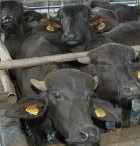 I am a fan of gatas ng kalabaw (carabao milk) and its by-products. Being a local of Los Baños, where the Dairy Training Research Institute (DTRI) is located, carabao’s milk and its by-products like kesong puti (white cheese) and pastillas de leche (milk candy) sold along the streets is a common sight. I remember when I was a kid, carabao’s milk was sold in long- necked bottles carefully sealed with banana leaves. Even the white cheese was then packaged with banana leaf to keep its freshness.
I am a fan of gatas ng kalabaw (carabao milk) and its by-products. Being a local of Los Baños, where the Dairy Training Research Institute (DTRI) is located, carabao’s milk and its by-products like kesong puti (white cheese) and pastillas de leche (milk candy) sold along the streets is a common sight. I remember when I was a kid, carabao’s milk was sold in long- necked bottles carefully sealed with banana leaves. Even the white cheese was then packaged with banana leaf to keep its freshness.
Today, these traditional means of packaging carabao milk and cheese are rare. What we have now are the dainty packaging we see in the malls, products displayed in stalls that sell chilled carabao’s milk in carefully sealed bottles, pastillas and cheese wrapped ornately in all their glamor. Yes, even my old time favorite carabao milk’s packaging did change. That “promdi” (provincial) touch is gone.
Carabao, not only a farm buddy
Carabao, an indigenous livestock resource in the Philippines, plays an integral component in every smallholder mixed farming systems. True to its nature, the carabao is a domesticated animal that is not only a farmer’s bestfriend but has become a symbolical source of power for every Filipino farmer. The advent of new technologies like high-powered tractors and other machines introduced in the field slowly displaced the carabao’s role in the field. There are areas in the country, though, where carabaos are still the farmer’s beast of burden. Or, maybe, these are the small farmers who cannot afford the expensive modern farming machinery.
The carabaos do not only play a lead role in traditional farming as they are also our main source of protein. The carabao meat (or carabeef) is an important ingredient in processed foods i.e., sausage, luncheon meat, meat loaf, etc. Even the canned corned beef is partly composed of carabeef. Manufacturers of processed meat are in dire need of carabeef because of its inherent high water holding capacity especially in processed form. The products containing carabeef are attractive to consumer because they do not lose much of their original form when cooked. Moreover, compared to beef, carabeef is cheaper, making the cost of production highly competitive.
More than the meat, carabaos are also a profitable source of milk either sold fresh or processed.
Milking profit from the carabao
According to the Philippine Carabao Center (PCC), carabao’s milk is considered the “most complete food” because it contains protein, fat, lactose, vitamins and minerals, and water. Carabao’s milk is richer and creamier than cow’s milk or goat’s milk due to its high percentage of milk fat which is a good source of energy. It contains riboflavin or Vit. B2 needed for normal growth, agent against skin swelling, inflammation of the lining of mouth and tongue, and dizziness. It has Vit. A for clear eyesight and Vit. D, calcium, and phosphorus for strong teeth and bones.
Carabao’s milk, when it’s still in the mamary gland is still clean and free of microbes. But once the milk has been secreted from the mamary gland, it easily becomes susceptible to bacteria that come from the surroundings, air, materials used in milking, or human interactions. Since the milk is highly nutritious, it becomes an efficient medium for the bacteria to spread. This is the reason why fresh milk are spoiled easily.
PCC identified three ways to maintain the freshness of carabao’s milk. Immediately after milking, fresh milk must be stored inside an ice box or refrigerator. Second, milk must be pasteurized or cooked to kill the microbes and be safe to drink. This is usually done by heating the milk for 30 minutes at 63oC or 15 seconds at 72oC. The milk should be chilled and maintained at temperature of 4-8oC. The third and last means is proper storage. If not all consumed, milk must be stored in an ice box or refrigerator to control the spread of microbes that are not killed during the pasteurization process.
To avoid wastage, milk must be processed. Pasteurized milk, choco milk, pastillas de leche, kesong puti, milk-o-jel, condensed milk, cheese spread, ice cream, mozzarella, or rennet (coagulated milk) are just some of the many products from carabao’s milk.
Pastillas de leche is one favorite native delicacy or sweets. With a tinge of the Spaniards’ influence, as the name implies, it is made simply of milk and sugar. Since the ingredients are simple, the finest possible quality milk and sugar is absolutely very important. Bulacan is well-known for pastillas production but lately some of the best pastillas made from pure carabao milk come from Nueva Ecija. Aside from pastillas, there is also the ever famous kesong puti which is the Philippines’ version of the salty cottage cheese made from carabao’s milk. Another ingenious product of cheese making in the country is our very own carabao mozzarella. The appearance is somewhat similar to the typical mozzarellas of the Italian, but our version has slight grey pastiness when sliced.
Source: Rita T. dela Cruz- bar.gov.ph, July-September 2006 Volume 8 No. 3
Do you like this Money Making Business Idea? content”> then please consider subscribing to our RSS feed. You can also subscribe by email and have new articles sent directly to your inbox. (Once you entered your e-mail address, you need to login to your e-mail account and click the link to confirm your subscription).
Great article, Thanks for your great information, the content is quiet interesting. I will be waiting for your next post.
Hi, blog hopping.